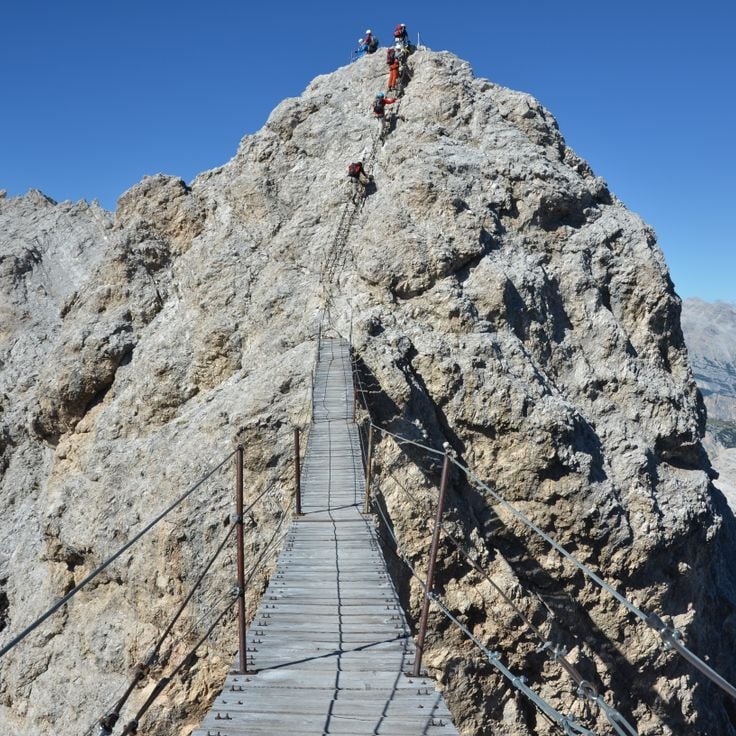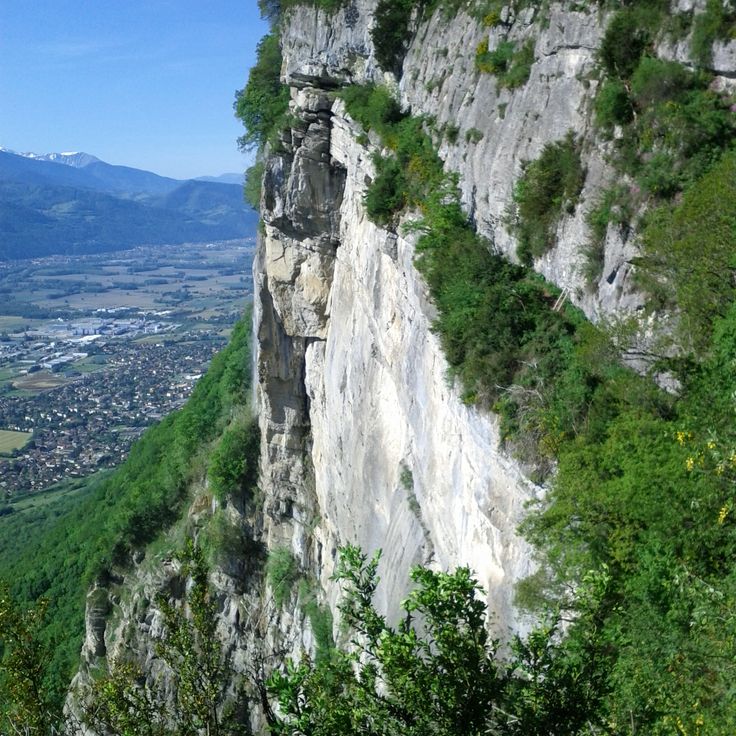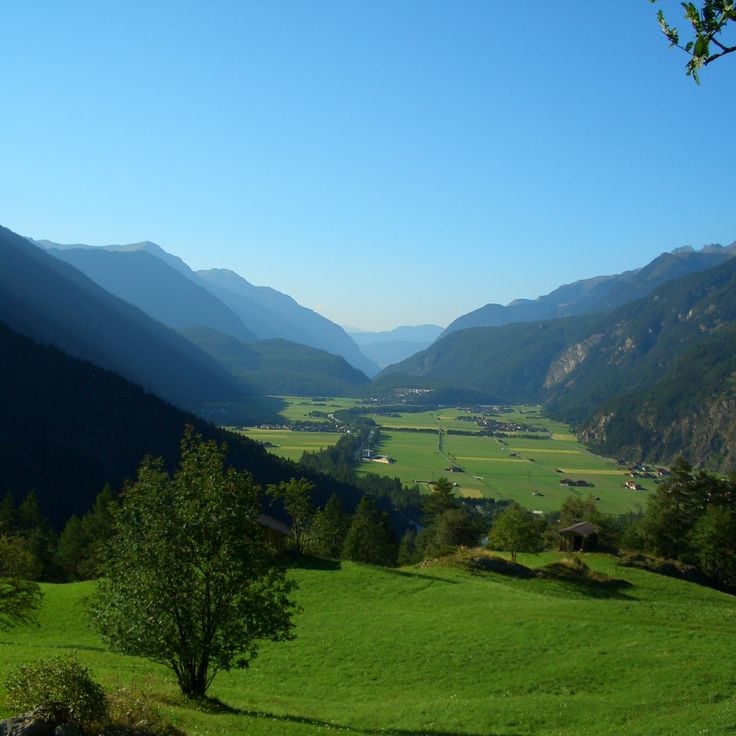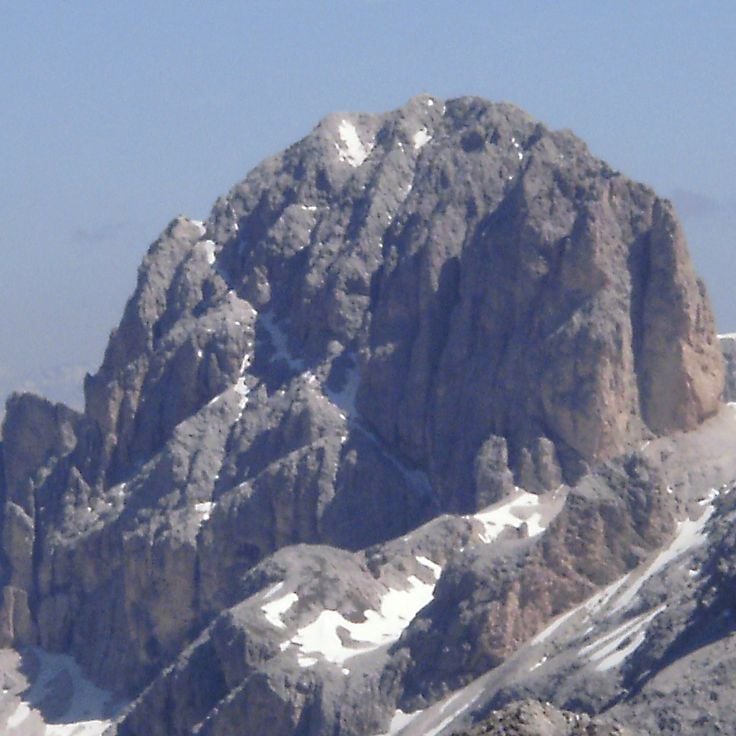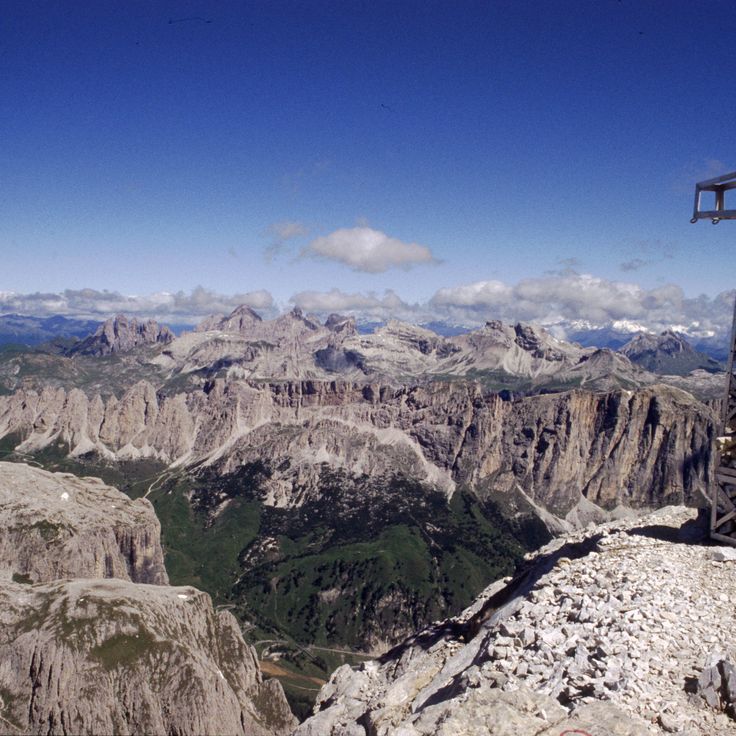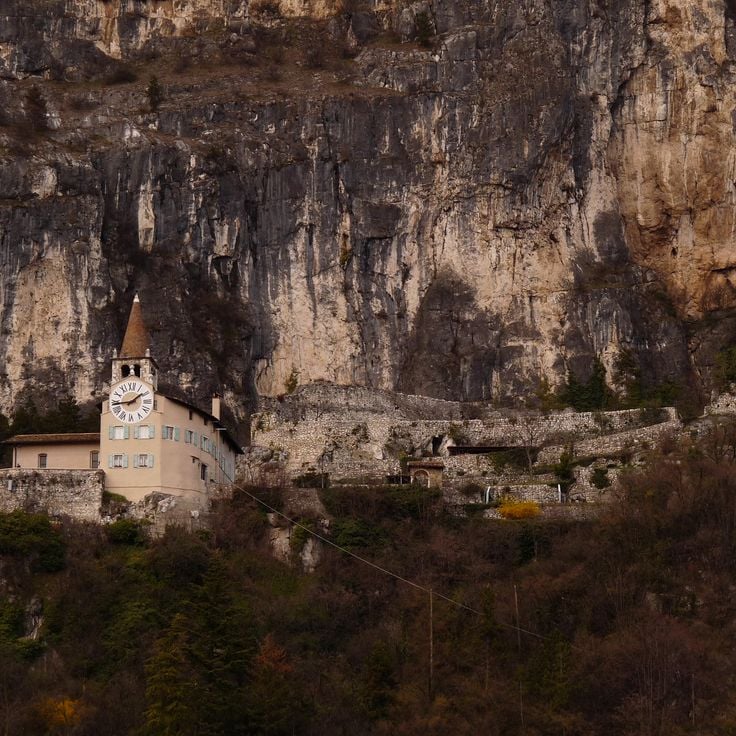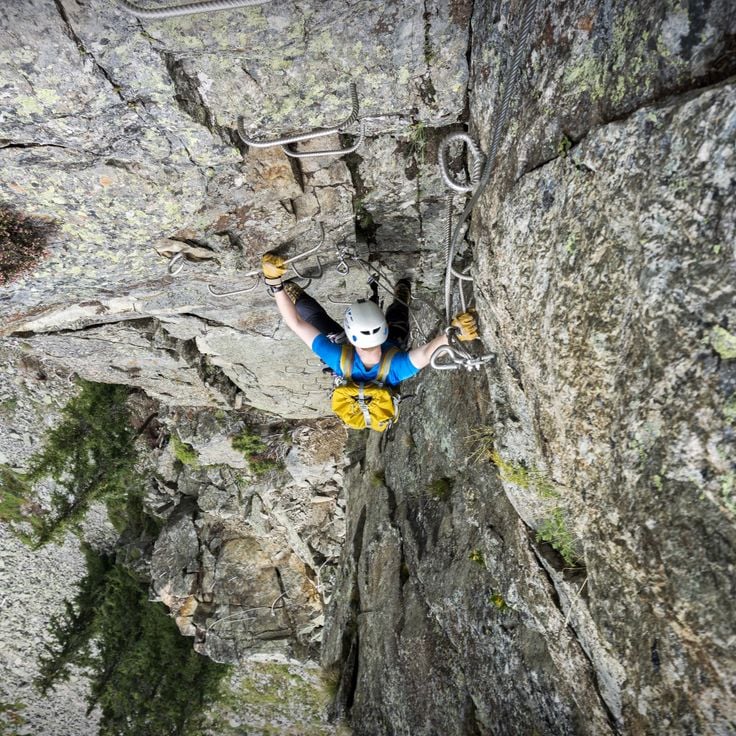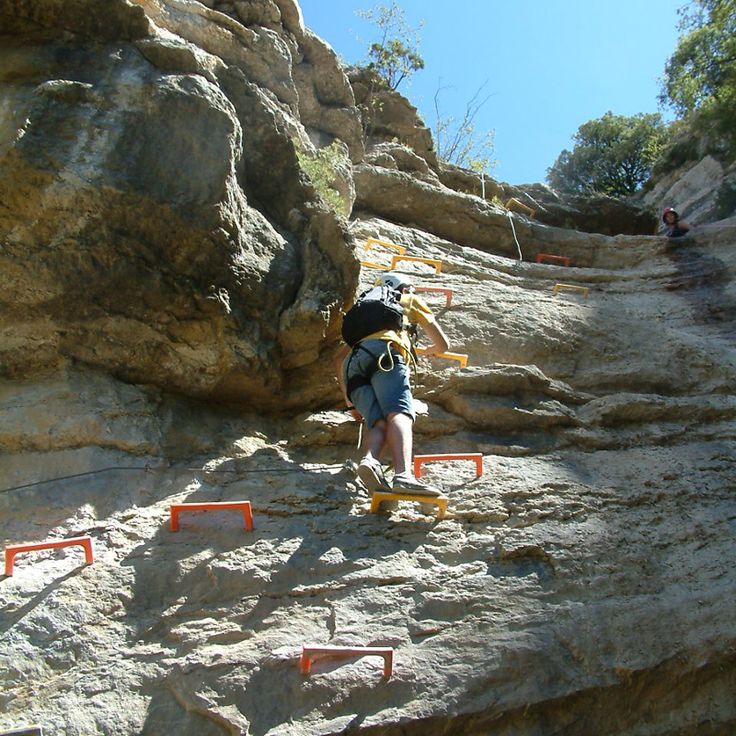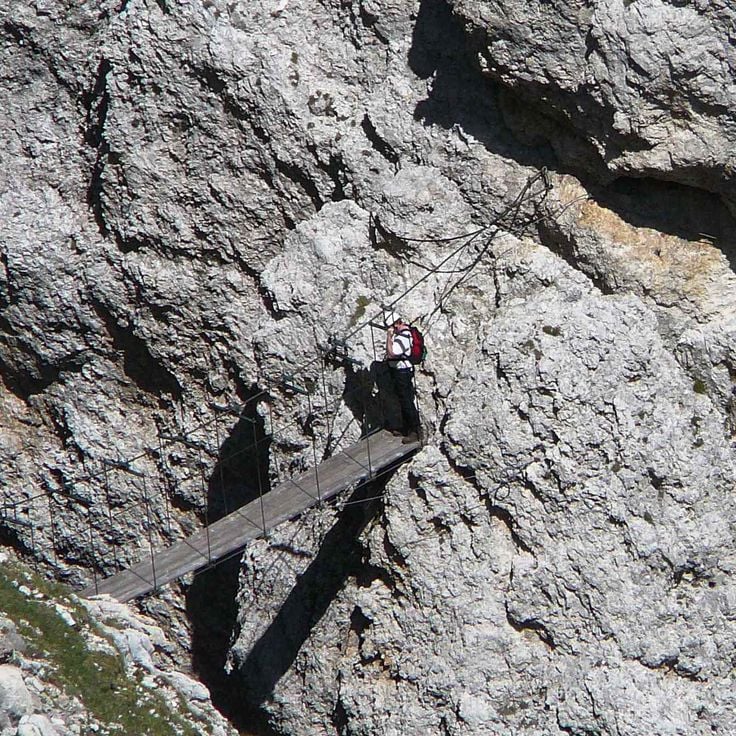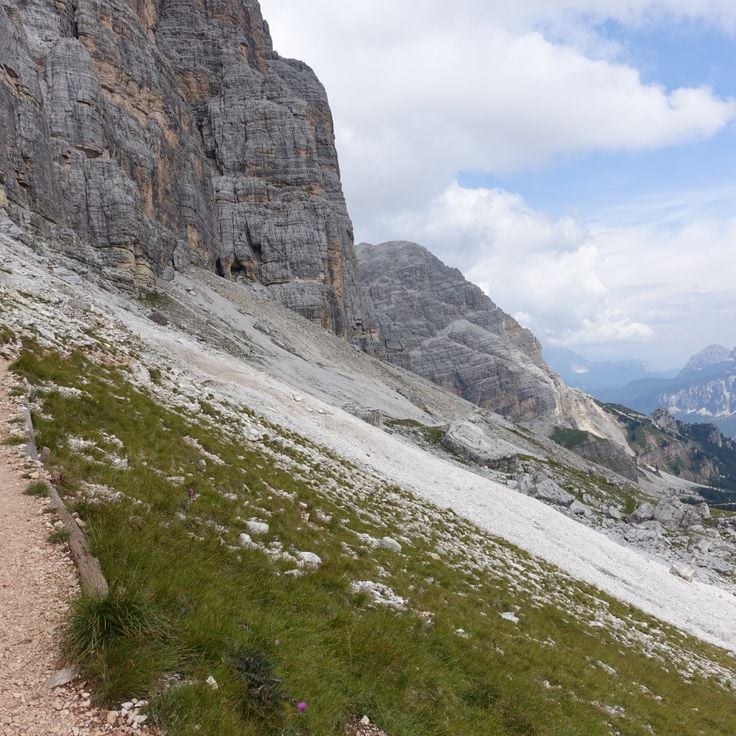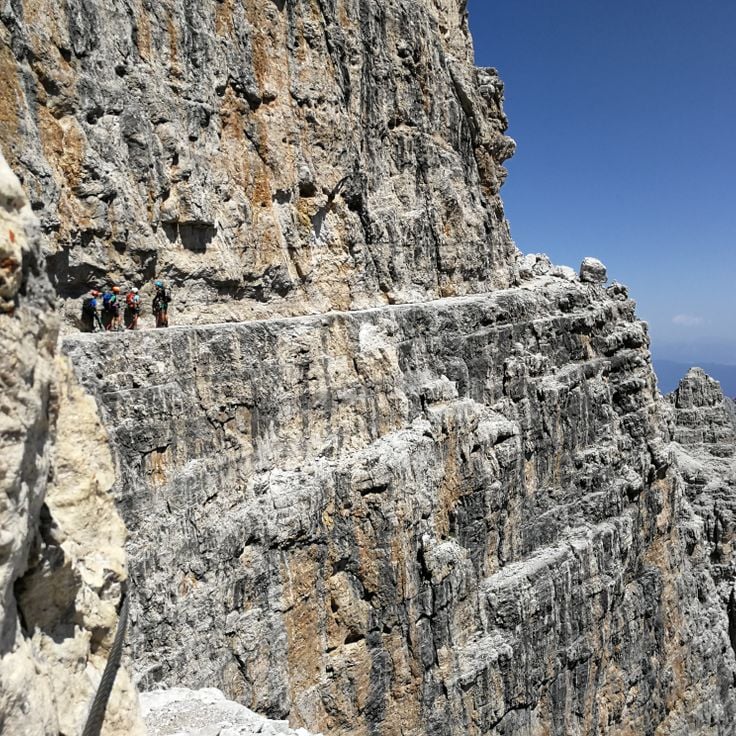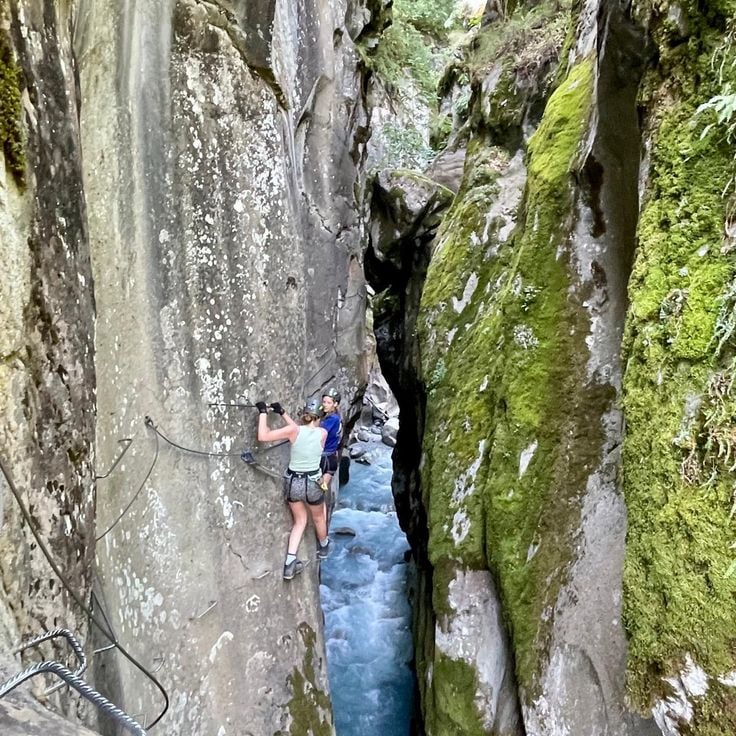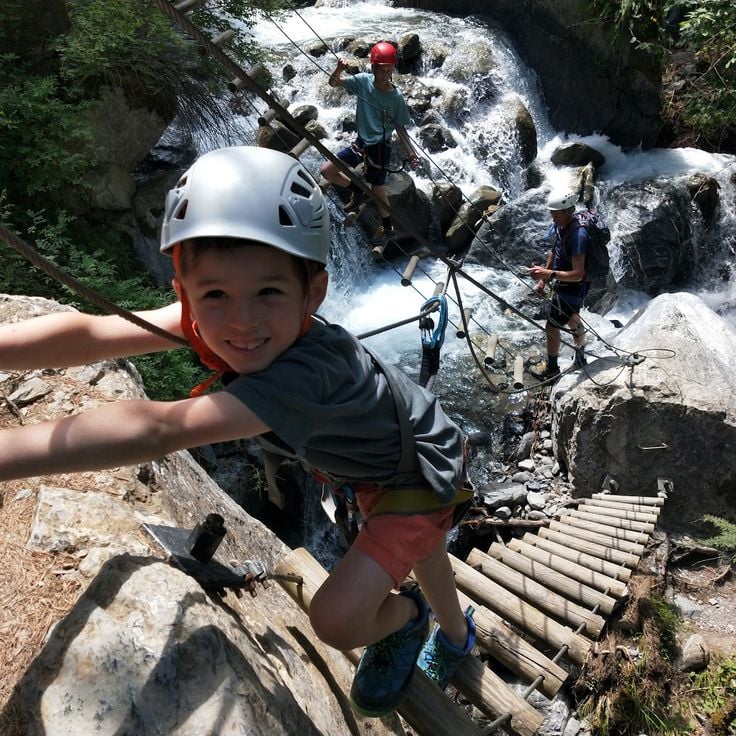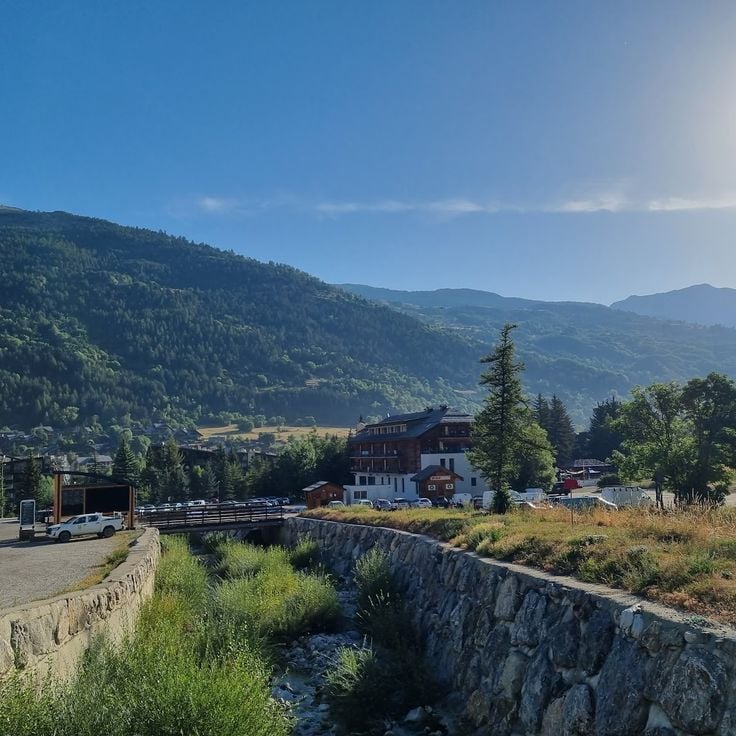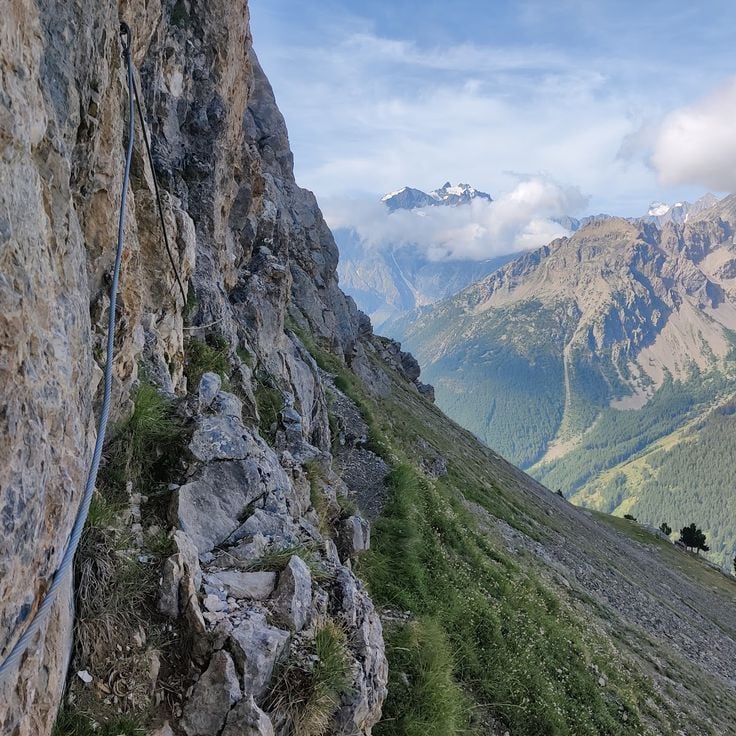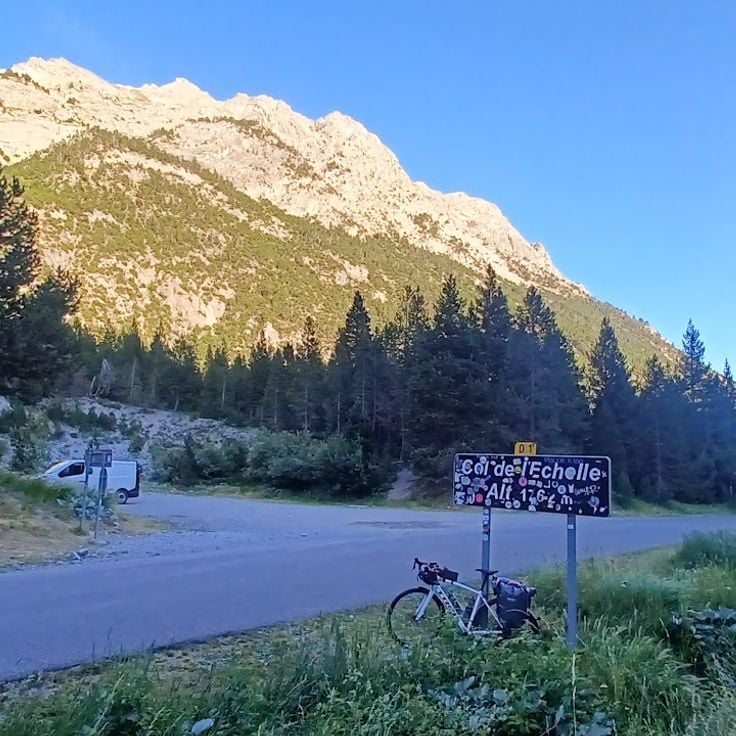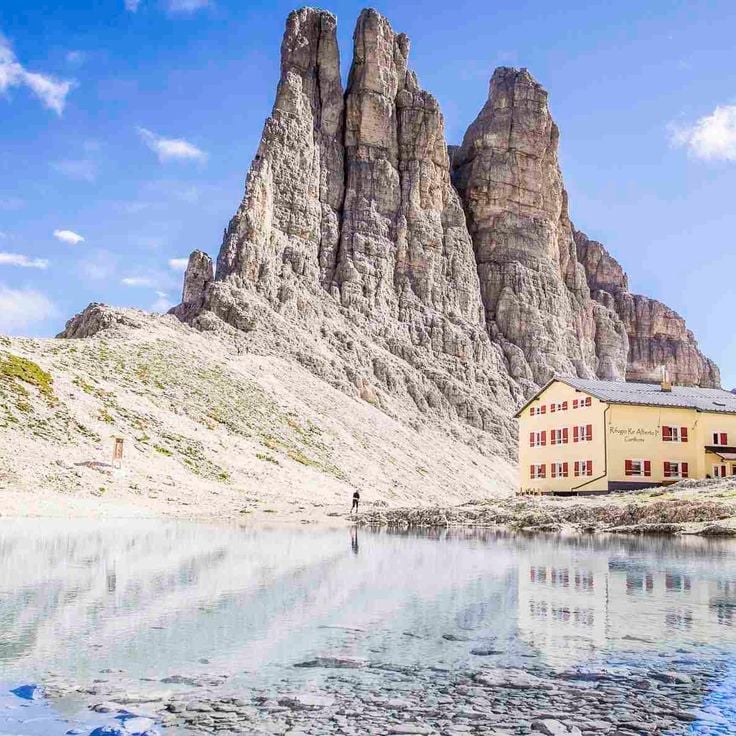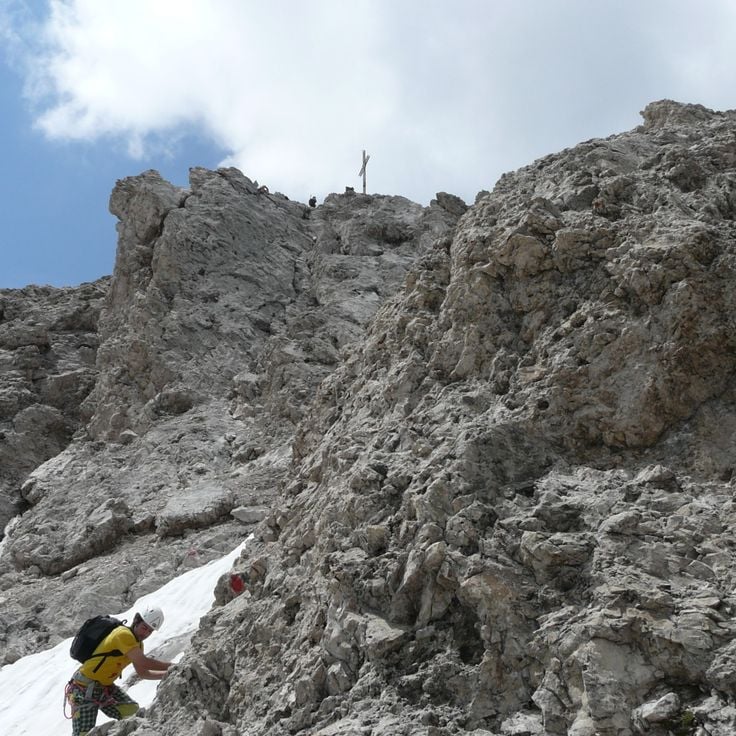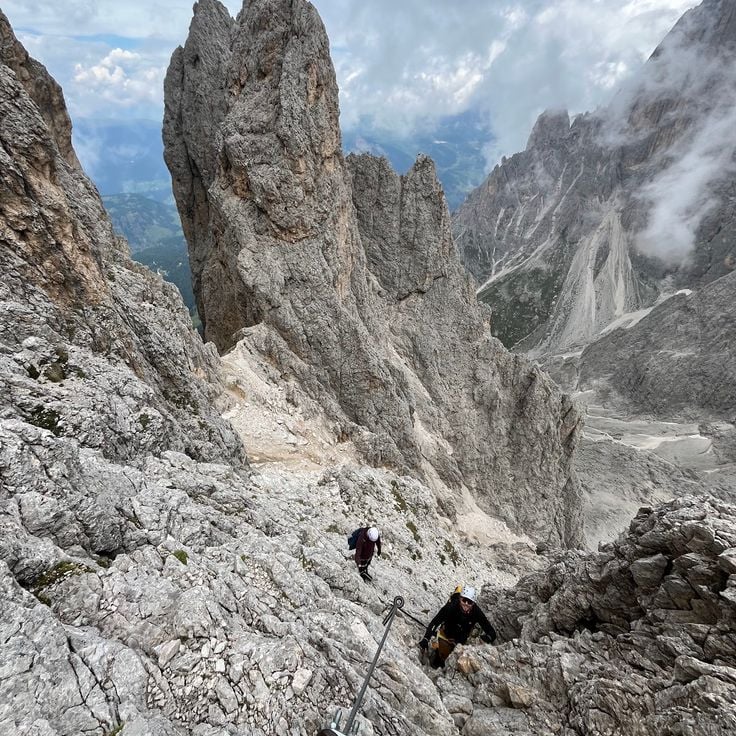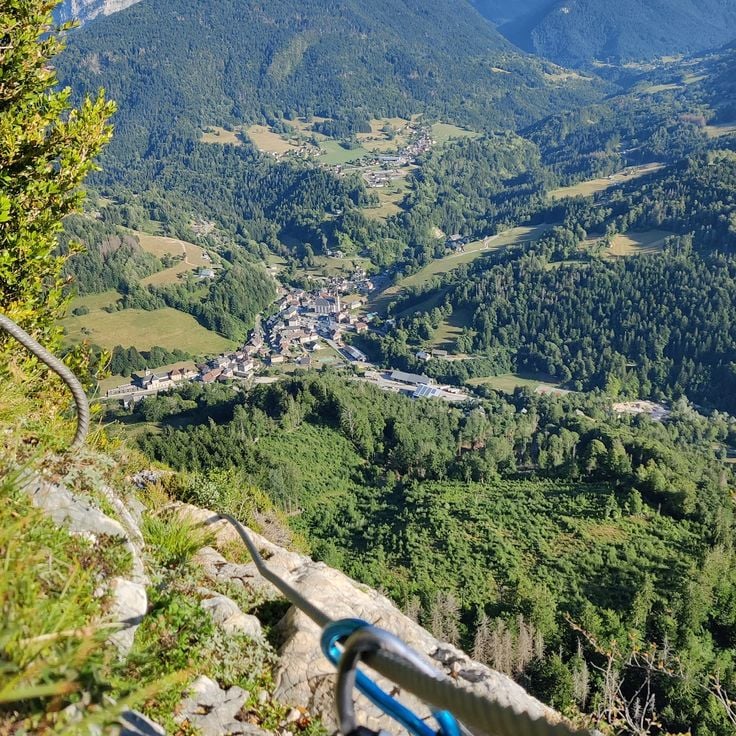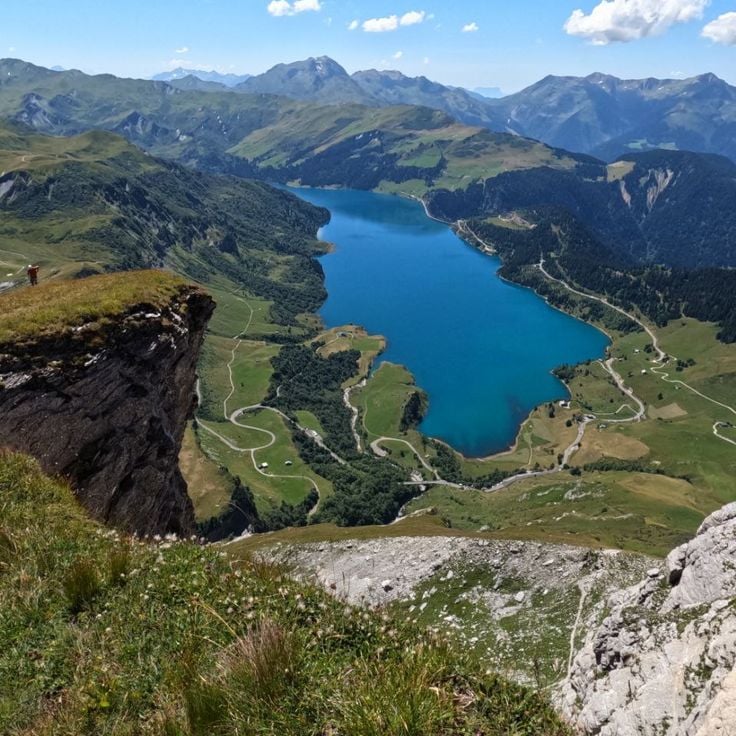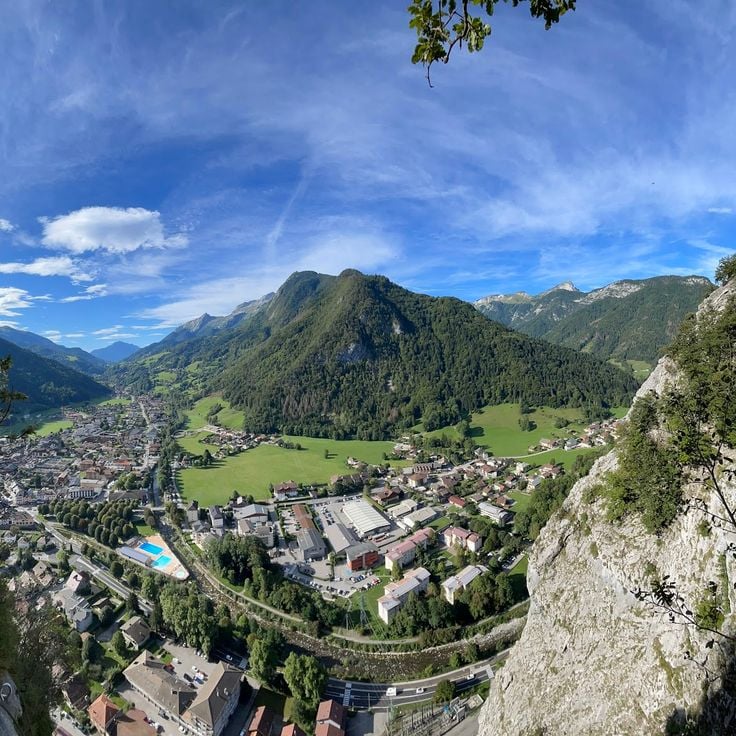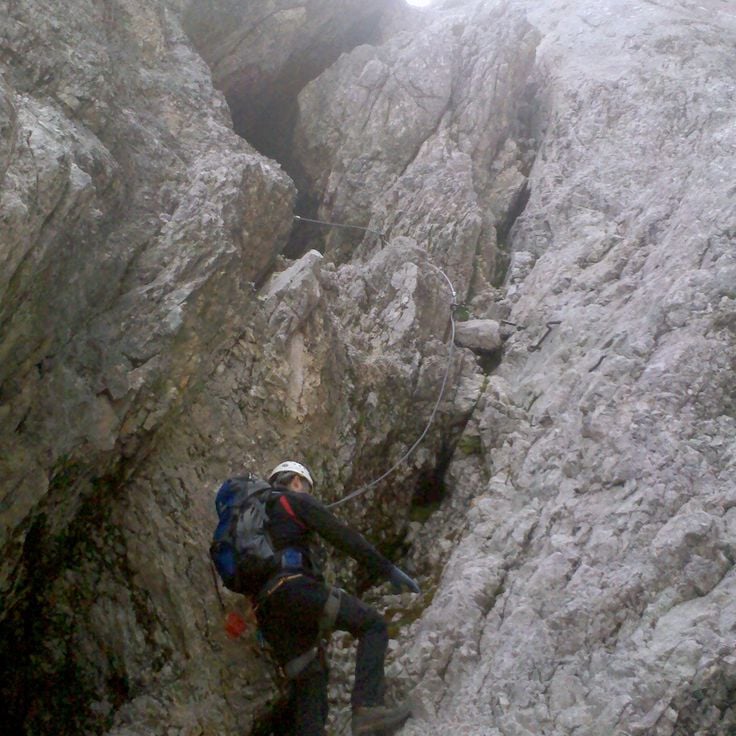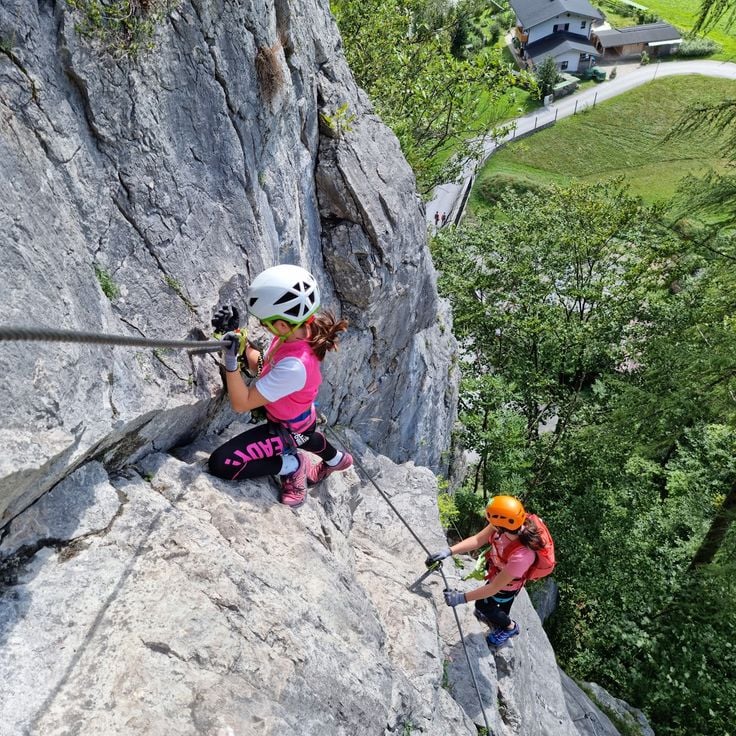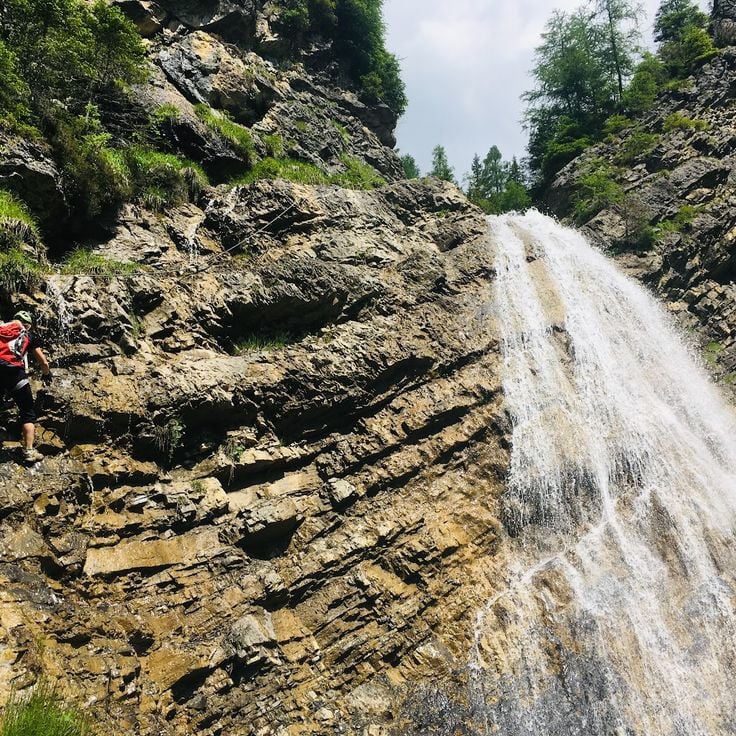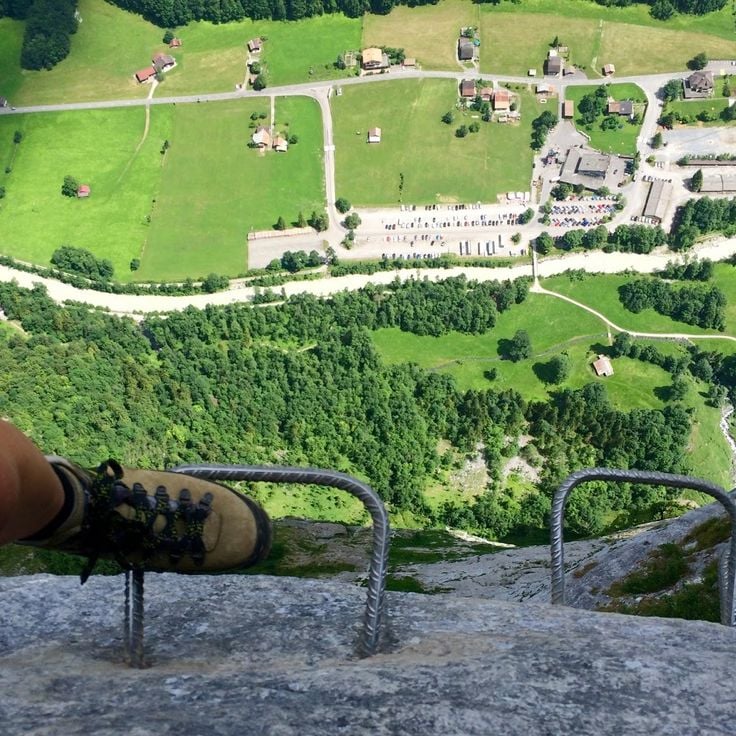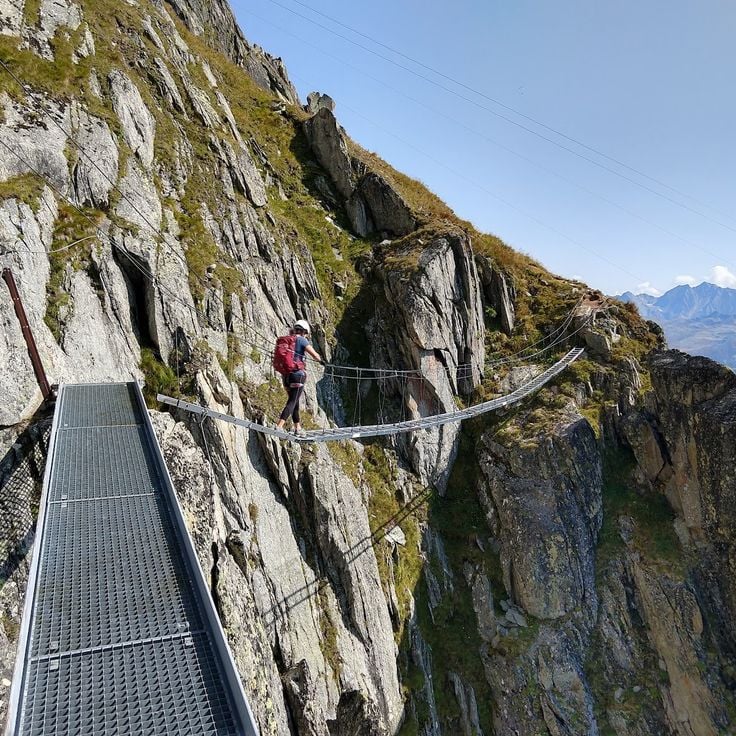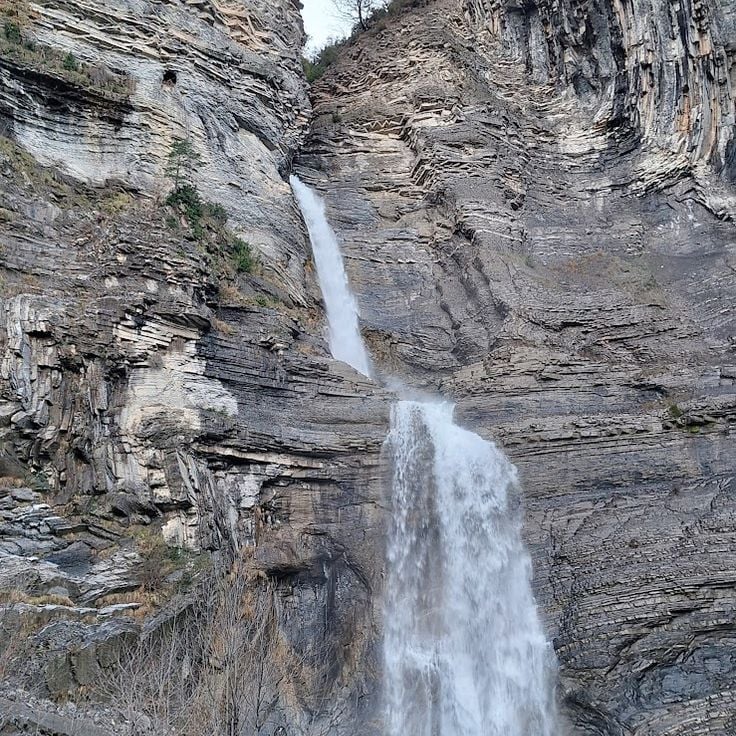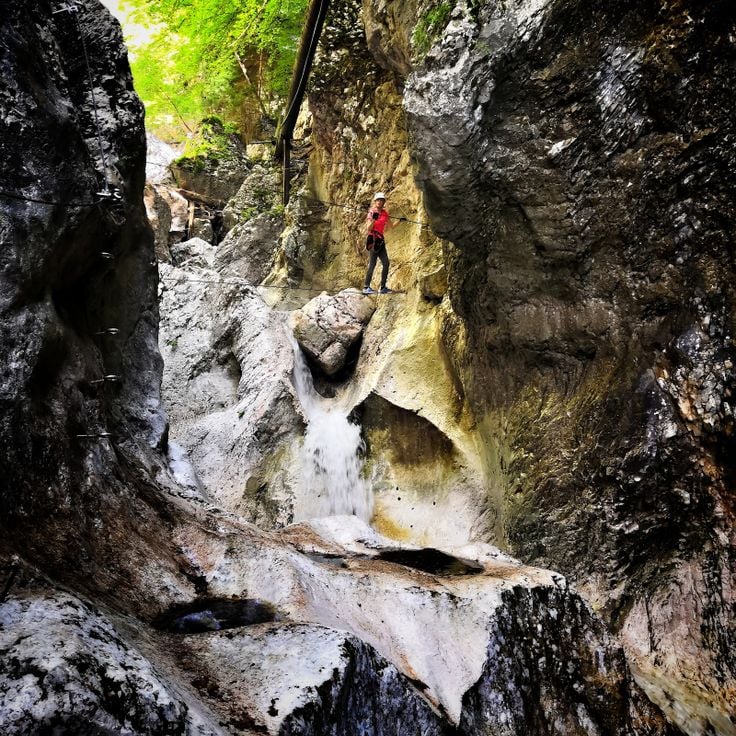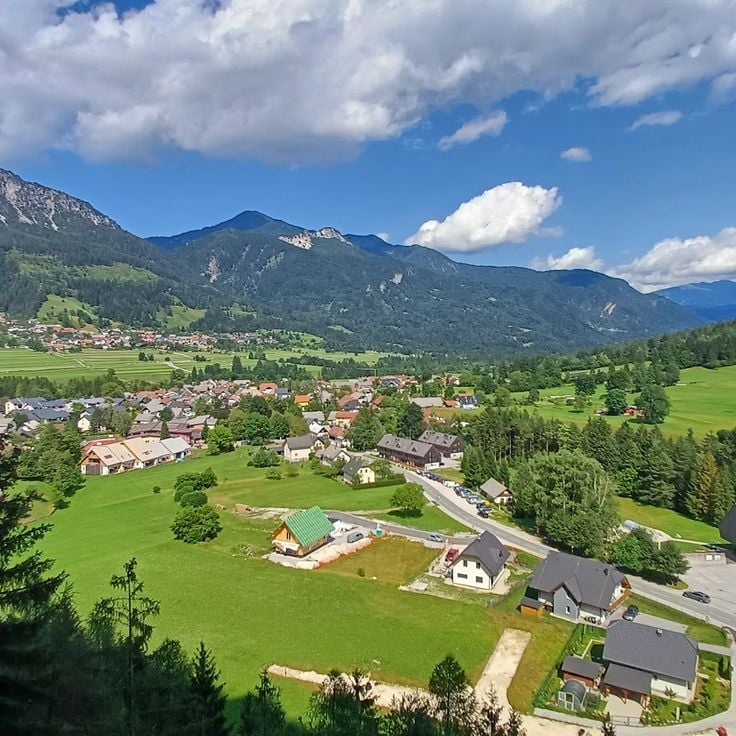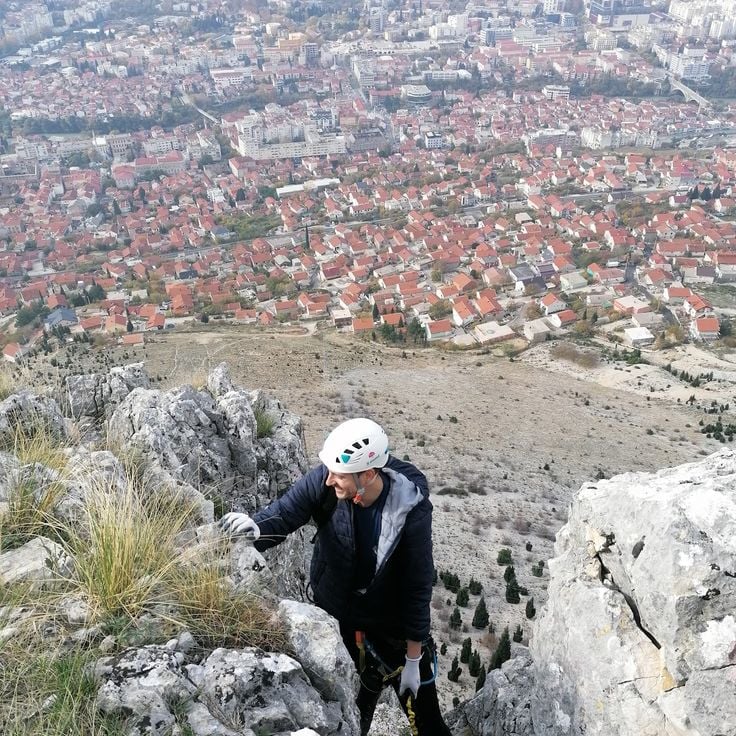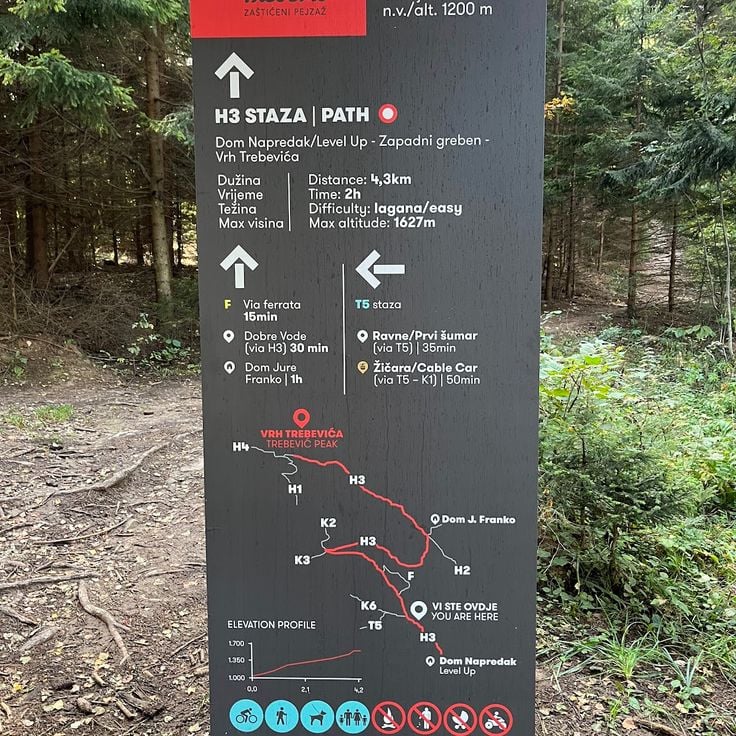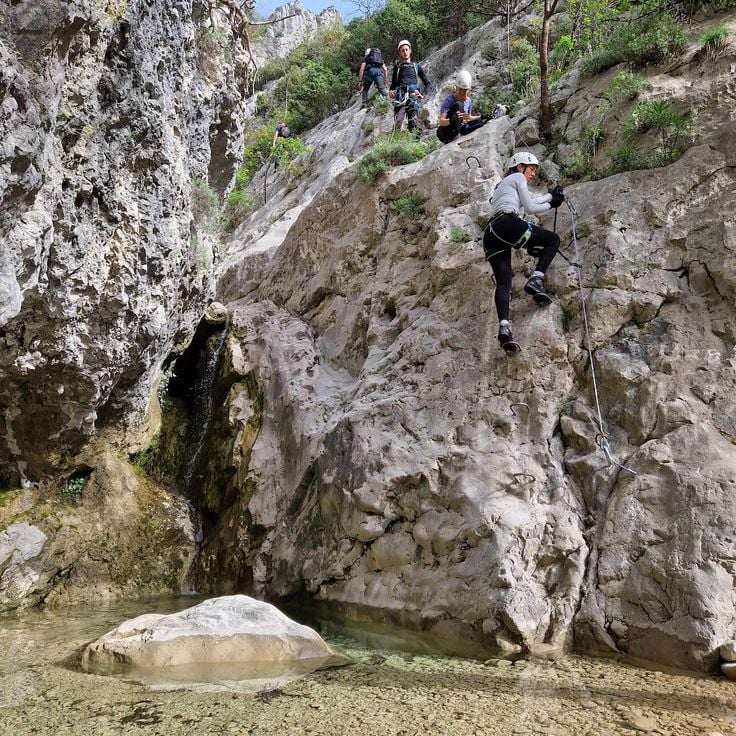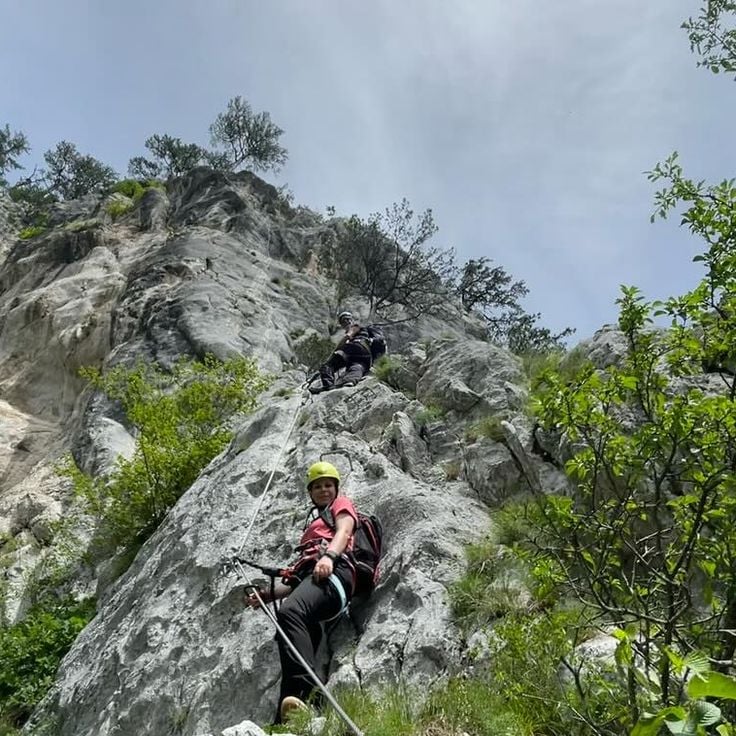Via ferrata routes in the Alps combine steel cables, metal rungs, and bridges into protected climbing paths through alpine rock faces. The routes extend through the Dolomites, French Alps, Austrian Ötztal, and Swiss mountain regions between 2,600 and 9,800 feet in elevation. Routes such as the Ivano Dibona or Cresta Ovest della Marmolada follow former military paths from World War I. Routes like the Via Ferrata de la Cascade in Auvergne-Rhône-Alpes run alongside waterfalls and gorges. In the Salzkammergut and Grisons regions, routes such as Postalm and Schwarzhorn access summits and mountain lakes. The Spanish Voie Olmo near Alicante offers Mediterranean climbing sections in limestone cliffs. Technical sections with overhangs and traverses alternate with secured walking passages. Most via ferrata require climbing harnesses and appropriate equipment.
The Via Ferrata Ivano Dibona follows a route through the Dolomites, combining technical climbing sections with historical elements from World War I. The trail crosses a 27-meter (89-foot) suspension bridge dating from the war period and traverses rock faces using steel cables and ladders. The route provides views of surrounding mountain ranges and valleys. This via ferrata reaches elevations between 2,000 and 2,700 meters (6,600 and 8,900 feet) and requires secure footing on exposed terrain. The limestone formations of the Dolomites shape the character of this protected mountain path.
The Via Ferrata de la Cascade follows the course of a waterfall in the French Alps and leads through vertical rock faces with permanently installed steel cables and footholds. The route runs along the cascades and requires basic climbing techniques as well as experience with safety equipment. The path combines sections along the rock face with passages that run directly beside the falling water, where proximity to the current demands additional concentration. The climbing route provides access to different levels of the waterfalls and allows observation of the geological formations of the region.
This via ferrata in the Ötztal Alps was named after an Austrian mountaineer who died on Annapurna in 1991. The secured climbing route with difficulty rating E follows technically demanding passages equipped with steel cables, brackets, and ladders. The route runs between 7900 and 9200 feet (2400 and 2800 meters) through granite cliffs and provides access to peaks of the Ötztal Alps. The via ferrata requires alpine experience and sure-footedness on steep rock sections.
This via ferrata on the Marmolada follows the Cresta Ovest to the summit at 10,968 feet (3,343 meters), the highest point in the Dolomites. The route ascends through alpine rock formations and uses military tunnels from World War I that Austrian and Italian forces built between 1915 and 1918. The path combines technical climbing sections with historical structures and reaches glaciated terrain near the summit zone. Starting from Passo Fedaia at 6,749 feet (2,057 meters), the ascent gains approximately 4,265 feet (1,300 meters) through steep walls and exposed ridges.
This via ferrata follows limestone cliffs in the Dolomites with several technical climbing sections. The secured route with steel cables and ladders ascends through the mountain massif to 8,710 feet (2,655 meters) and provides views of the surrounding Dolomite peaks.
This via ferrata in the Dolomites follows vertical rock walls with secured passages and provides views of the Sella massif. The route combines technical sections along steep limestone faces with traverses through alpine terrain. The path moves through different landforms with metal cables, footholds, and anchors attached to the rock surfaces. The ascent reaches elevations that overlook the surrounding peaks and valleys of the Dolomites.
This Via Ferrata Monte Albano provides secured ascents through steep limestone sections with steel cables, ladders, and metal holds. The route passes through the geological formations of Monte Albano near Mori and connects technical climbing passages with views over the Adige Valley. The trail requires physical strength and climbing experience when navigating the vertical rock faces and overhanging sections between 1,300 and 3,000 feet (400 and 900 meters) elevation.
The Via Ferrata des Evettes offers secured climbing routes with steel cables through the French Alps. The course combines horizontal traverses with vertical ascents and includes routes for beginners along with more technically demanding sections for experienced climbers. The routes lead through alpine rock formations and reach elevations with views of the surrounding peaks and valleys of the Auvergne-Rhône-Alpes region.
The Voie Olmo follows vertical rock walls with steel cables that end at an elevation of 2,600 feet (800 meters). This via ferrata in the mountains near Alicante extends over 650 feet (200 meters) of wall height and connects technical sections with views of the Mediterranean mountain landscape. The secured climbing route follows the natural rock structure with ladders and metal steps. The route through the Spanish coastal mountains belongs to the via ferratas that run between limestone formations and mountain ridges.
The Postalm via ferrata route follows a mountain stream through a limestone gorge in the Salzkammergut, connecting secured steel cable sections with crossings of several waterfalls. This via ferrata traverses geological limestone formations shaped by water erosion and offers technical passages along the rock faces above the stream bed. The route incorporates fixed ropes and metal grips for movement through the narrow gorge sections while water descends over multiple tiers. The path belongs to the alpine via ferratas in the Austrian mountains and provides access to the vertical rock structures of the region.
The Voie Tridentina follows limestone walls in the Dolomites and includes 2,000 feet (600 meters) of secured sections with steel cables. This via ferrata crosses a suspension bridge at mid-height and connects vertical passages with technical climbing sections. The route follows historical war paths from World War I through the rock formations. From the upper sections, views extend across the surrounding peaks and valleys of the region.
The Voie Lipella traverses a network of World War I tunnels while ascending 3281 feet (1000 meters) of elevation gain. This via ferrata in the Dolomites connects military relics with alpine climbing sections. The route follows historical defense installations along steep rock faces. Steel cables and ladders secure the ascent through war tunnels and across exposed passages. The trail documents mountain warfare in this sector of the Italian Alps.
The Via Ferrata Schwarzhorn ascends through rocky terrain to an elevation of 10,325 feet (3,147 meters). This climbing route follows steep walls and provides views of the surrounding peaks of the Swiss Alps. The route combines technical sections with steel cables and ladders that secure the ascent to Schwarzhorn. The trail ranks among the high-alpine climbing routes in the Grisons mountains and requires experience with secured climbing.
The Via ferrata delle Bocchette Centrali runs through the Brenta Dolomites and connects several mountain huts at elevations between 7900 and 9500 feet (2400 and 2900 meters). This climbing route traverses steep rock faces, narrow ridges, and exposed chimneys with steel cables and metal ladders. The route links Rifugio Alimonta with Rifugio Brentei and requires a head for heights and experience in alpine terrain.
The Via Ferrata des Gorges d'Ailefroide follows a gorge in the Écrins Alps of Hautes-Alpes. This protected climbing route traces the Torrent d'Ailefroide through narrow rock passages between vertical granite walls. Steel cables and metal rungs secure the path through sections with overhangs and traverses above the mountain stream. The route runs at elevations between 5400 feet (1650 meters) and 6070 feet (1850 meters) above sea level. The itinerary starts at the Ailefroide parking area and continues through the gorge to Refuge du Glacier Blanc. Several technical sections require harness and via ferrata equipment.
The Via Ferrata de La Combe follows limestone walls in the French Alps, connecting steel cables, footholds, and exposed traverses between 2950 and 3950 feet (900 and 1200 meters). This climbing route traces natural rock fissures and ridges through steep terrain with several technical sections requiring strength and balance. The route consists of vertical passages with metal rungs and aerial crossings over rocky gorges. Between the secured climbing sections, the paths pass through alpine meadows and pine forests. Harness, via ferrata kit, and sturdy footwear are required.
This via ferrata on Rocher du Bez follows vertical limestone walls in the French pre-Alpine region. The route uses fixed steel cables and metal rungs through technical sections with overhangs and exposed traverses. The course connects multiple wall sections between 2625 feet and 3281 feet (800 and 1000 meters) in elevation and includes passages over smooth rock slabs. The terrain requires a harness, via ferrata set, and helmet for the secured sections.
The Via Ferrata L'Aiguillette du Lauzet follows a rock ridge above the Durance Valley in the Southern Alps. This climbing route leads through vertical sections with metal rungs and horizontal traverses along narrow rock ledges. The course sits at 3,300 feet (1,000 meters) above sea level and provides views of the surrounding alpine peaks and the Serre-Ponçon reservoir area. The route combines steep ascents on steel cables with exposed passages above the valley. The Via Ferrata L'Aiguillette du Lauzet requires a harness and appropriate safety equipment for the technical sections.
The via ferrata of Aiguilles Rouges follows the rock faces of the massif of the same name, located across from the Mont Blanc range in the French Alps. This protected climbing route uses steel cables, metal rungs, and bridges through steep sections and overhangs between 6600 and 8200 feet (2000 and 2500 meters) in elevation. The route provides views of Mont Blanc and the Chamonix valley. This via ferrata includes technical sections with climbing and secured walking passages along the red granite cliffs.
The Vajolet Towers rise as distinct rock formations in the Dolomites above San Giovanni di Fassa. These limestone needles reach heights between 2,821 and 2,821 feet (2,821 meters) and form a characteristic silhouette of the Rosengarten massif. Several via ferratas lead through the north faces and across the ridges of the towers, including routes with technical passages and ladder sections. The Santner via ferrata runs below the Vajolet Towers and connects various rock ledges. From the Vajolet Hut, climbers reach the starting points of the via ferratas in about one hour of walking. The routes through the towers require sure footing and a head for heights when crossing exposed rock faces.
The Via Ferrata Sass Rigais follows protected climbing sections through Val Gardena in the Dolomites to one of the distinctive peaks of the Geisler group. The ascent combines iron ladders and steel cables along steep limestone walls with alpine walking passages at elevations between 8200 and 9800 feet (2500 to 3000 meters). This via ferrata follows natural rock fissures and ridges through the mountain massif located between Val Gardena and the Villnöss Valley. The route requires via ferrata experience and complete safety equipment including helmet and climbing set. The Sass Rigais forms part of the geological formation of the Puez-Geisler group with characteristic dolomite limestone layers. Several hours of walking time are needed for ascent and descent from the starting point near the Puez Hut.
The Ferrata Schuster follows a historical route through the Sexten Dolomites in South Tyrol. This via ferrata connects the Auronzo Hut with the Paternkofel saddle at approximately 8040 feet (2450 meters) elevation, using steel cables and metal rungs installed along the rocky mountain flanks. The route crosses steep sections and rock passages with views of the surrounding Dolomite peaks. The via ferrata was named after mountaineer Heinrich Schuster and follows paths that date partly from World War I. The Ferrata Schuster requires via ferrata experience and standard equipment including a harness and via ferrata set for the protected passages.
This via ferrata extends 1,480 feet (450 meters) along a vertical limestone face in the Chartreuse Alps. The route consists of metal rungs, steel cables, and two suspension bridges crossing rock gaps. The route starts at 3,940 feet (1,200 meters) elevation and ascends the north face of Roche Veyrand. Technical difficulty includes overhanging sections and exposed traverses overlooking the valley. The via ferrata was installed in 2008 and uses existing geological features of the limestone formation. The descent follows a marked hiking trail through beech forests. Harness, via ferrata kit, and helmet are required.
The Via Ferrata Roc du Vent follows steep rock faces in the French Alps, connecting natural climbing passages with installed steel cables and steps. The secured route proceeds through rock overhangs and traverses at elevations between 3,900 and 5,200 feet (1,200 and 1,600 meters). The technical sections require climbing movements on vertical walls, while flatter passages cross rock slabs and narrow ledges. This via ferrata is part of the Alpine climbing route infrastructure and requires standard via ferrata equipment with harness and safety set. The route provides access to mountain areas that would be difficult to reach without the installed security features.
The Via Ferrata de Thônes runs through limestone walls above Thônes in the Savoie Alps at elevations between 2,600 and 3,300 feet (800 to 1,000 meters). The route connects steel cables, metal rungs, and footholds along the natural rock formation. The course follows cracks and ledges through alpine terrain with sections that traverse vertical walls and narrow passages. The route requires a climbing harness, helmet, and proper safety equipment for technical sections that demand handholds on installed grips and ladders.
The Vias Ferratas du Diable in Aussois are part of the alpine via ferrata network in the Savoie Alps and run at an elevation of approximately 6600 feet (2000 meters) through limestone cliffs above the Maurienne Valley. These routes combine steel cables, iron rungs, and climbing sections with technical passages and traverses along the rock faces. The via ferratas provide access to the mountain slopes and viewpoints over the Vanoise massif. The installation follows the geological formations of the region and requires a harness and proper safety equipment for the ascent.
This via ferrata in Thueyts runs through the volcanic landscape of Ardèche on a route that combines climbing sections over basalt rock faces, steel cable ladders, and exposed traverses. The course follows a cliff wall above the Ardèche gorge and offers technical passages with vertical ascents and horizontal traverses. The route includes multiple difficulty grades and passes through geological formations of volcanic origin. Access starts from the village of Thueyts, and the course requires standard via ferrata equipment including harness and lanyard system.
The Stopselzieher climbing route in Tyrol belongs to the alpine systems that use steel cables, metal rungs, and secured passages. This route leads through rock faces between 2600 and 9800 feet (800 and 3000 meters) in elevation and combines technical sections with walking passages. The route requires a harness and appropriate equipment for ascending the secured walls.
The Zahme Geis Via Ferrata in Montafon combines steel cable routes with ladders and footholds through limestone walls of the Zimba mountain group. This climbing route starts at 5900 feet (1800 meters) elevation and leads through several technical sections with vertical passages and exposed traverses to the summit area. The route follows natural rock fissures and ridges of the Verwall Group with views across the Rätikon massif and Montafon valley. Descent follows marked mountain trails to Lindauer Hütte. The via ferrata requires climbing harness, helmet and appropriate safety equipment.
The Klettersteig Millnatzenklamm follows a protected route through the gorge of the same name in Carinthia, combining secured trails with sections along rock faces and waterfalls. The route runs over steel cables, iron steps and several suspension bridges through the narrow valley of the Millnatzenbach stream between Trebesing and Malta. The via ferrata offers sections with varying difficulty grades and views of the surrounding mountain ranges of the Carinthian Nock Mountains. Completion requires via ferrata equipment including helmet, harness and via ferrata set and takes approximately two to three hours.
Klettersteig Mürren-Gimmelwald connects two mountain villages in the Bernese Oberland through a secured mountain route with steel cables and metal holds. This via ferrata follows steep rock faces between 4485 and 5413 feet (1367 and 1650 meters) in elevation and features technical sections with vertical passages and traverses. The route requires sure footing and proper safety equipment including a harness and via ferrata set for the approximately two-hour climb.
Klettersteig Eggishorn runs through the Bernese Alps with views of the Aletsch Glacier and surrounding peaks. The route follows rock faces and ridges between 7,200 and 9,600 feet (2,200 and 2,900 meters) in elevation. Steel cables and iron rungs secure the climbing sections along the steep passages. This via ferrata connects alpine climbing segments with short walking sections over scree and rock. Ascent requires a harness, helmet, and appropriate equipment for high mountain terrain.
The Vía Ferrata de Los Duendes connects protected climbing sections with steel cables and metal rungs along a Mediterranean rock face in Spain. The route follows limestone sections with technical traverses and overhanging passages typical of Spanish via ferratas. This route belongs to the Mediterranean climbing routes of the Iberian Peninsula and provides access to vertical rock formations between 980 feet and 2,600 feet (300 and 800 meters) in elevation. The route requires a climbing harness and appropriate safety equipment for navigating the exposed sections above the Mediterranean terrain.
This via ferrata runs through the Slovenian Alps with technical sections across rock walls and ridges. The Hvadnik climbing route uses steel cables and metal rungs for protection along the path. The course includes several vertical passages and traverses through alpine terrain. Climbers cross different rock formations between forested slopes and open mountain faces. The route connects climbing sections with secured walking passages through the mountains.
The Via Ferrata Mojstrana Top follows the rock faces of the Slovenian Alps near Mojstrana at the edge of Triglav National Park. This via ferrata route runs along the walls above Vrata Valley with technical sections on limestone. The path combines steel cables and metal rungs for ascending vertical passages and traverses. The route reaches exposed wall sections with views across the surrounding Julian Alps. The via ferrata requires proper equipment and experience with alpine conditions between 3300 and 5900 feet (1000 and 1800 meters) in elevation.
Via Ferrata Mostar combines steel cables, iron rungs, and safety fixtures to form a climbing route above the Neretva gorge in Herzegovina. The course follows limestone walls above the city of Mostar and includes sections with vertical ascents and secured crossings. The route extends for several hundred yards through varied terrain formations with rock fissures and overhangs. Climbers require via ferrata equipment, helmet, and appropriate gear for the technical passages.
Bijele stijene is a via ferrata in the mountains of Bosnia-Herzegovina that follows secured climbing routes across rocky terrain. This route combines steel cables, metal rungs, and footholds to provide access to the steep limestone walls. The via ferrata runs through forested slopes and offers technical sections with vertical movement along the rock faces. The secured passages alternate with walking sections as the route traverses the mountain landscape. Like other via ferrata in the region, this Bijele stijene route requires a climbing harness and appropriate safety equipment for traversal.
The Via Ferrata Podružje in Bosnia and Herzegovina combines steel cable sections, metal rungs, and rock traverses along a limestone wall. This via ferrata extends over several hundred feet of vertical elevation and follows natural rock formations with technical passages and secured walking sections. The route passes through areas with overhangs and traverses that require via ferrata experience and comfort with heights. This via ferrata requires climbing equipment including harness, helmet, and via ferrata set.
The Paolo Dieci via ferrata routes in Bosnia and Herzegovina establish metal-secured paths along vertical rock faces in the Dinaric Alps. The routes combine steel cables, metal rungs, and climbing sections at elevations between 3,900 and 7,200 feet (1,200 and 2,200 meters). The courses traverse limestone formations with technical passages and walking sections. Paolo Dieci developed the via ferrata routes as part of the mountain infrastructure in the region. The routes require harness, helmet, and proper safety equipment. The via ferrata courses connect with hiking trails through the surrounding mountain ranges.
